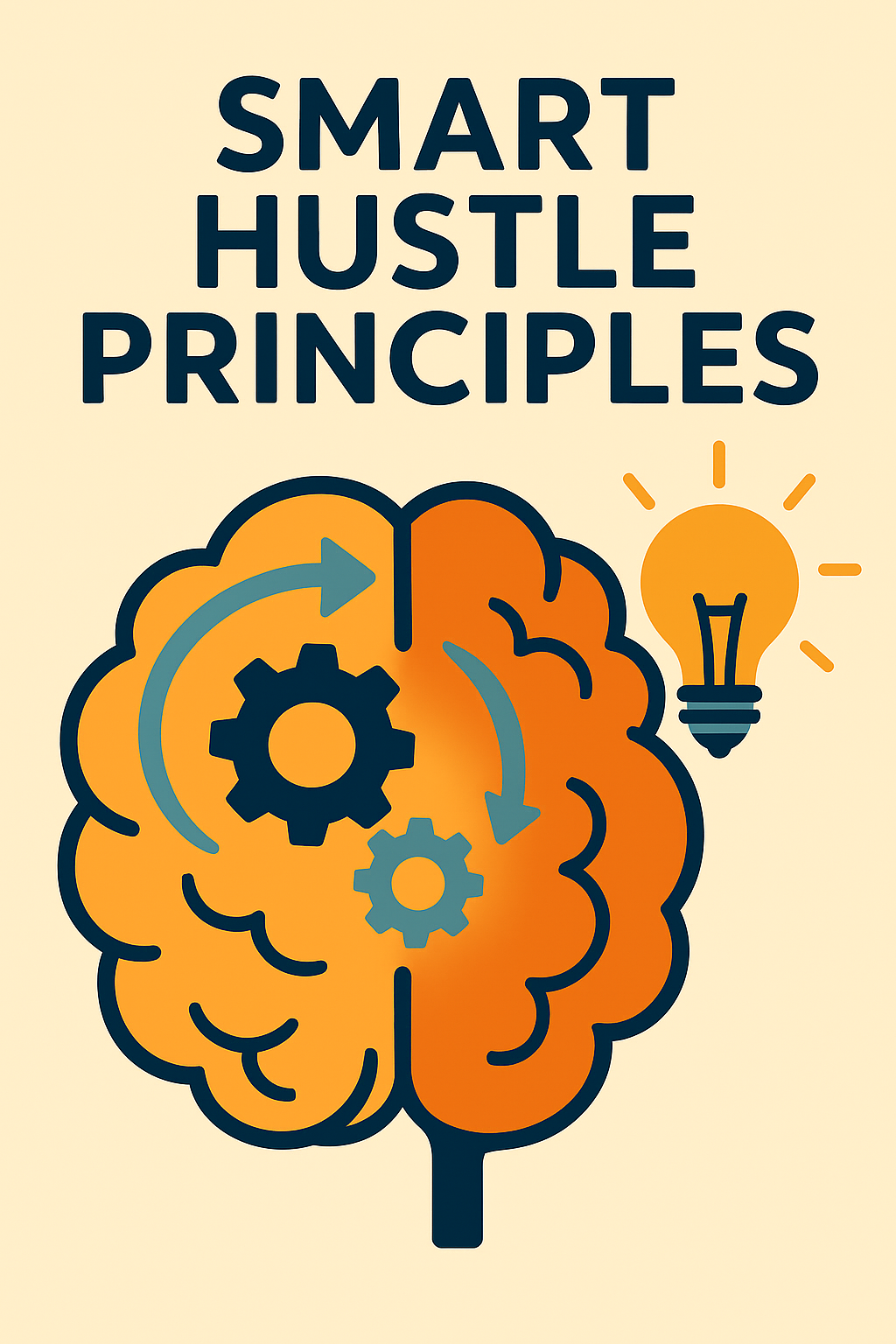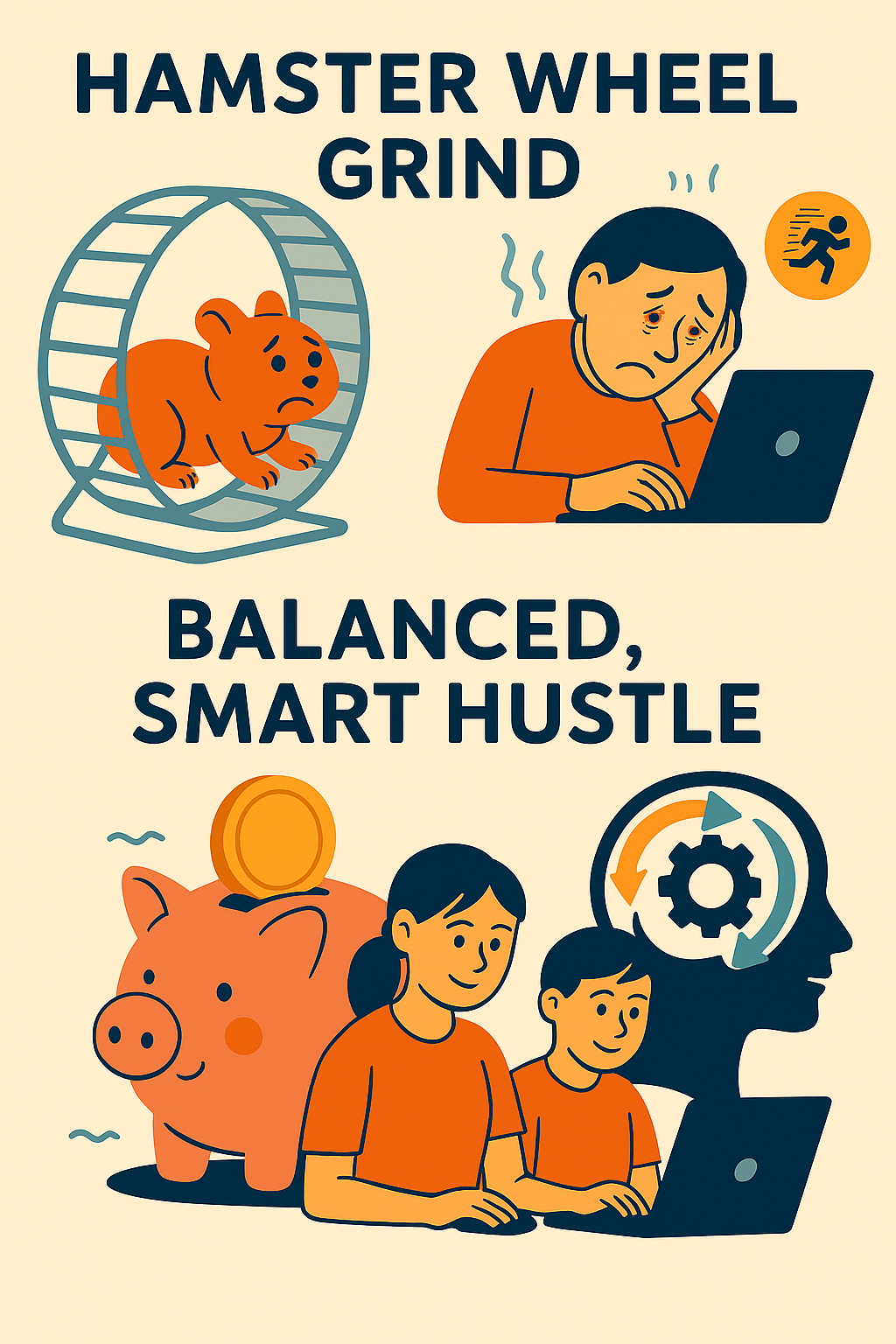Most people equate “hustle” with sleepless nights, an overstuffed calendar, and caffeine-powered heroics. research on productivity, psychology, and performance shows that working hard is far less effective than working smart. The real secret is combining deliberate focus with strategic leverage so that every hour invested yields out-sized results while still leaving room for rest, learning, and life.
Why “Smart” Beats “Hard” Every Time

1. The 80/20 Reality
Italian economist Vilfredo Pareto observed that roughly 80% of consequences flow from 20% of causes. Applied to hustle, it means a small slice of your tasks or clients drives the bulk of your outcomes. Hard workers try to muscle through the other 80% as well, whereas smart hustlers locate the high-leverage 20% and double down there.
2. Energy, Not Just Time
Peak performers allocate their most alert hours to cognitively demanding projects and reserve lower-energy windows for routine work. That shift alone can raise output without adding minutes to the day.
3. Systems Trump Willpower
Willpower is exhaustible; systems are automatic. Automation platforms, SOPs, and templates turn repeating chores into self-running workflows456. Every process removed from your to-do list frees mental bandwidth for strategy and creativity.
4. Quality Beats Busyness
Heavy email traffic, endless status meetings, and rushed multitasking feel industrious but rarely move key metrics. Research from collaboration platforms shows that streamlining communication, batching messages, and adopting asynchronous updates improve delivery speed while slashing unnecessary effort.
5. Sustainable Pace Fuels Consistency
Overwork triggers cognitive fatigue, error rates, and eventually burnout9. Smart hustlers schedule breaks, respect sleep, and treat rest as fuel for tomorrow’s breakthroughs.
Five Mindset Shifts That Unlock Smart Hustle

1. Adopt a Growth Perspective
Stanford psychologist Carol Dweck found that believing skills are learnable (“growth mindset”) drives greater persistence, creativity, and achievement than assuming traits are fixed. When you view proficiency as expandable, you seek efficient learning loops instead of grinding longer at current limits.
2. Define Success With SMART Goals
Loose wishes encourage drift; well-structured objectives focus attention. SMART goals—Specific, Measurable, Achievable, Relevant, Time-bound—clarify targets and create built-in accountability. For example: “Publish four client-attracting blog posts by 31 August, each generating 500+ views” is easier to execute than “do more marketing.”
3. Think in Systems, Not Siloes
Systems thinking views every outcome as the product of interconnected parts. Rather than micromanaging tasks, map the whole process (inputs, feedback loops, bottlenecks). Fixing a single upstream constraint often multiplies downstream capacity—a smarter play than simply pushing harder at the end of the pipeline.
4. Embrace the 80/20 Lens Daily
At the start of each week ask: Which 20% of projects, prospects, or features will create 80% of this week’s value? Schedule those first. Delegate, automate, or defer the rest.
5. Trade Perfection for Iteration
A bias for action beats flawless planning. Ship a minimum viable version, gather real-world feedback, refine. Agile sprints and Kaizen loops model this principle—and keep momentum high without marathon overnighters.
The Smart Hustle Toolbox: Tactics That Compound

1. Time Blocking & Deep-Work Windows
Reserve 90-minute, interruption-free blocks for priority tasks, protected by “do not disturb” modes and shut-door cues. Context-switching fragments attention; single-tasking amplifies it.
2. Automation, Delegation, and Templates
-
Automation: Use no-code tools to route invoices, client onboarding, follow-up emails, and data entry. Once set, each workflow runs indefinitely.
-
Delegation: Outsource low-skill, repeatable tasks to assistants or specialized contractors, freeing your schedule for high-leverage strategy.
-
Templates: Save replies, proposals, and slide decks as modular blueprints to cut creation time by 70%.
3. The Two-Minute Rule
If a task takes under two minutes—quick reply, file upload—do it immediately to prevent mental clutter. Longer items go onto a prioritized kanban board.
4. Batch Similar Tasks
Group errands, calls, or content creation into themed sessions to minimize setup costs and cognitive re-booting. For example, record all podcast intros in one sitting instead of scattering them across the week.
5. Pomodoro-Style Breaks
Work 25 minutes, rest 5. Four cycles = one “set,” followed by a longer 15-minute recovery. Studies show regular micro-pauses refresh focus and reduce error rates.
6. Leverage AI Assistants
AI meeting notetakers, summarizers, and scheduling copilots handle drudgery while you tackle insight-heavy analysis. The aim is not to replace thinking but to reduce admin drag.
7. Weekly CEO Day
Set aside one block each week to step back, audit metrics, adjust OKRs, and brainstorm. This meta-work keeps the entire system aligned and prevents mindless momentum.
8. Maintain a “Not-To-Do” List
Identify behaviours that sabotage smart hustle—habitual scrolling, scope creep, unfiltered notifications—and consciously avoid them. Subtracting distractions is often faster than adding productivity hacks.
9. Ritualize Rest and Renewal
Schedule exercise, social time, and eight hours of sleep like mission-critical appointments. Peak energy, creativity, and immunity stem from recovery, not nonstop push2223.
10. Continuous Learning in Bite-Sized Doses
Allocate 30 minutes daily for skill upgrades (course modules, industry reports, code practice). Frequent micro-learning keeps you adaptable without impeding project flow24.
Putting It All Together: Your Personal Smart Hustle Blueprint
-
Clarify Vision – articulate a single, inspiring north star (e.g., “Build a consultancy generating ₹1 crore by 2027 while working 30 hours per week”).
-
Set Quarterly SMART Objectives – revenue, product milestones, personal health.
-
Map Systems – diagram lead generation, delivery, and cash-flow loops; locate constraints.
-
Apply 80/20 & Time Blocking – front-load high-impact tasks into protected focus blocks.
-
Automate & Delegate – implement tools for invoicing, CRM updates, social posting; hire part-time help for admin.
-
Install Feedback Loops – weekly scorecard review, CEO day, customer interviews.
-
Iterate Relentlessly – ship, learn, refine. Celebrate progress, then elevate benchmarks.
Example Week Snapshot
| Day | AM Deep Work | Midday Micro-Break | PM Support Block | Evening Recharge |
|---|---|---|---|---|
| Mon | Draft client strategy deck | Walk + stretch | Client calls & Slack updates | Dinner, yoga |
| Tue | Build automation workflow | 5-min breathing | Admin & proposals | Movie night |
| Wed | Record course videos | Lunch unplugged | Edit content & schedule posts | Reading |
| Thu | Research prospect list | Coffee walk | Outreach emails | Gym session |
| Fri | Metrics & CEO review | Micro-nap | Creative brainstorming | Friends & family |
Common Pitfalls (and How to Dodge Them)
-
Busywork Masquerading as Progress – Continuously ask, “Would this matter if left undone?” If no, cut or delegate.
-
Tool Overload – Each new app adds a learning curve and context switch. Adopt only those that remove friction.
-
Perfection Paralysis – Remember: Version 1 > Version none. Shipping imperfectly is smarter than waiting for flawless.
-
Neglecting Recovery – Fatigue erodes judgement and speed. Schedule rest like a deliverable.
-
Goal Creep Without Resources – Ambition must match capacity. Use SMART tests to keep objectives reasonable and trackable.
Final Thoughts
Hustling smart is not about shirking effort—it’s about directing disciplined effort toward the few moves that compound. By marrying growth mindset, goal clarity, systemic thinking, and strategic automation, you can accomplish more in less time, with less stress. Start tomorrow morning: pick one high-leverage objective, block ninety focused minutes, mute distractions, and dive in. Repeat daily. The compound interest of smart hustle will soon outpace any amount of raw grind.